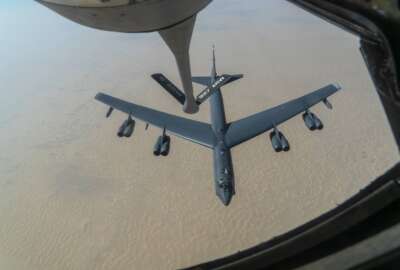A new model-based decision support tool will soon allow Air Force leaders to predict how a single investment decision can impact an entire program and its budget.
The first-of-its-kind decision advantage tool, called Rhombus Guardian, will help senior leaders to not just understand the direct costs of a particular decision, but also how that decision ripples through an entire ecosystem.
If Air Force leaders, for example, decided to add or take away an aircraft, the new tool would be able to highlight both the price tag of the plane and the implications of that decision on aircraft availability, personnel or other important domains.
“What’s really important about that is when we make investment decisions today, it’s based on Excel spreadsheets or PowerPoints. This tool will allow a senior leader to see the dynamic impacts if you’re going to invest in something — how does it ripple across the ecosystems of the Air Force, readiness, aircraft availability, strategic basing?” Joe McDade, assistant deputy chief of staff for plans and programs, told Federal News Network at the AFCEA Air Force IT day last week.
“It is an audacious thing that we’re trying to do. Frankly, it’s never been done at the scope and scale before,” he added.
For about three years, the Air Force has been working on the platform with Rhombus Power, a small business out of Silicon Valley. The team is now ready to introduce the first iteration of the tool in January 2024, with a series of spirals as the team continues to gain confidence in the applications.
To develop this tool, the team had to create meta-models for how the Air Force works. Having large models like weapons system sustainment in place will now allow them to tailor those models to individual weapon systems.
“If we’re going to buy an additional F35, I have to know what the sustainment costs are going to be when they’re gonna roll in, I have to know flying hours, I have to know manpower. And you say, ‘Well, how does all that stuff work?’ It took us three years to develop the meta-models to do that,” McDade said.
While the first iteration is nearing deployment, there are a lot of applications going through the development phase before they are implemented. Due to the complexity of what they are doing, McDade said, it is inevitable for the first version to have bugs.
“There is no doubt that when people start watching us make decisions, they’re going to attack the models, they’re going to attack the data. Our view of that is if you’ve got valid points, we’ll just roll it into continuous updates,” he said.
Air Force Secretary Frank Kendall ordered a major review of Air Force and Space Force organization and readiness in an open letter released in September. The review stage will be completed in January 2024, followed by an implementation phase.
McDade said they are trying to time the deployment of the new tool to support the secretary’s sweeping efforts to make the service agile and more optimized for “great power competition.”
“So what Secretary Kendall is saying to us inside the Pentagon is ‘I want digital decision support tools that are model-based, connected to authoritative data, have my best analytics, and my dream system is something that will optimize resources for me,’” McDade said.
“So we’re trying to time this deployment with the Secretary’s announcement of great power competition folded into what he’s doing. We’re going to make sure that the desktops are available to every stakeholder who has a need to know in the Air Force,” he added.
Copyright
© 2024 Federal News Network. All rights reserved. This website is not intended for users located within the European Economic Area.





